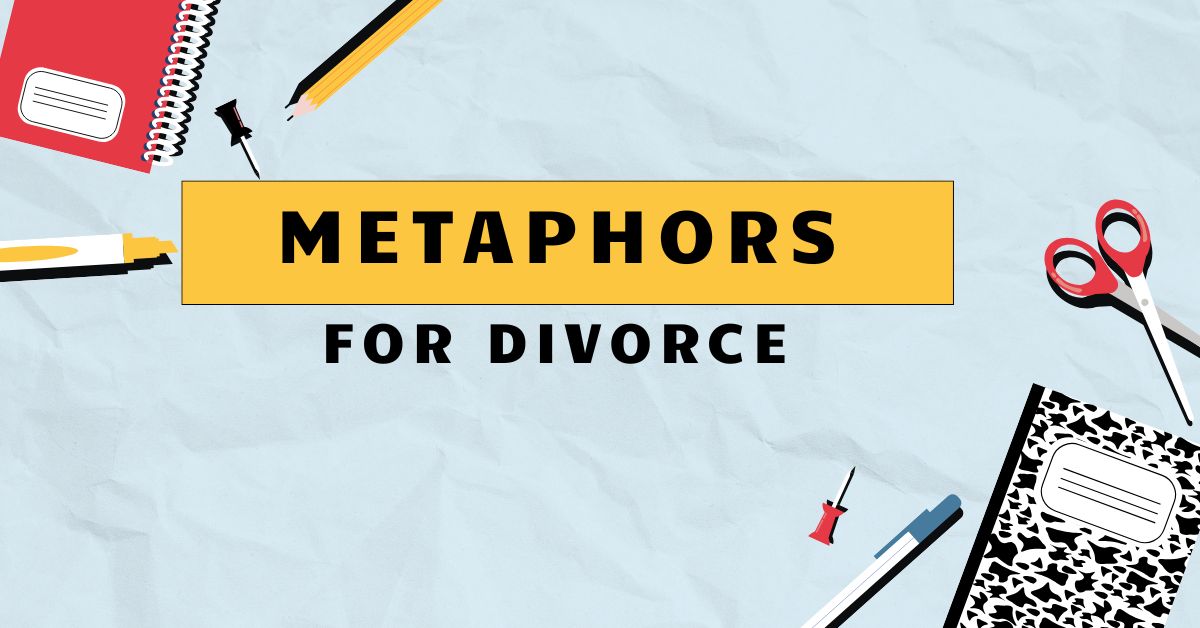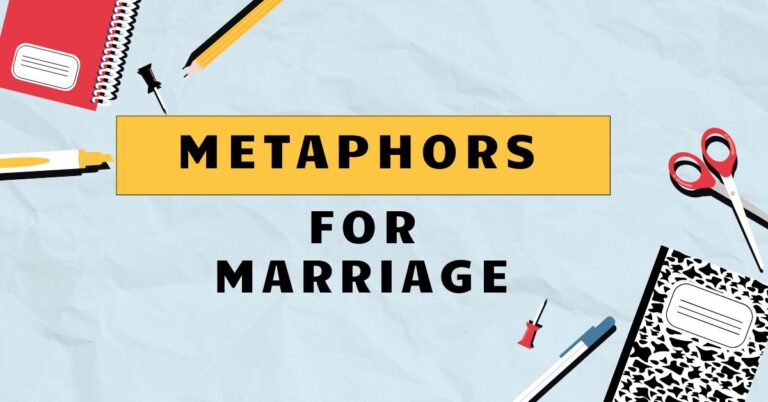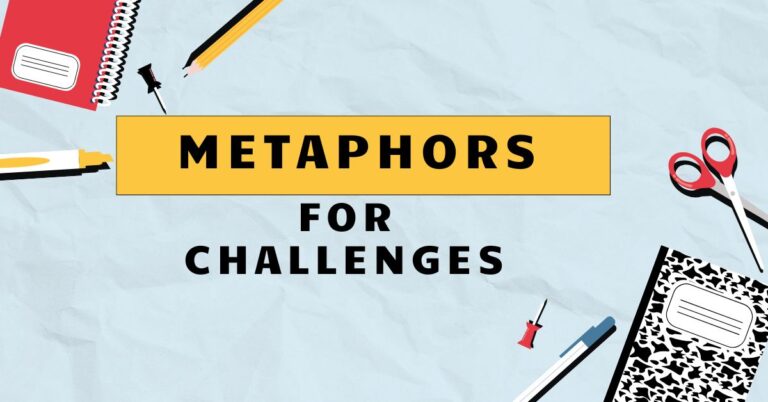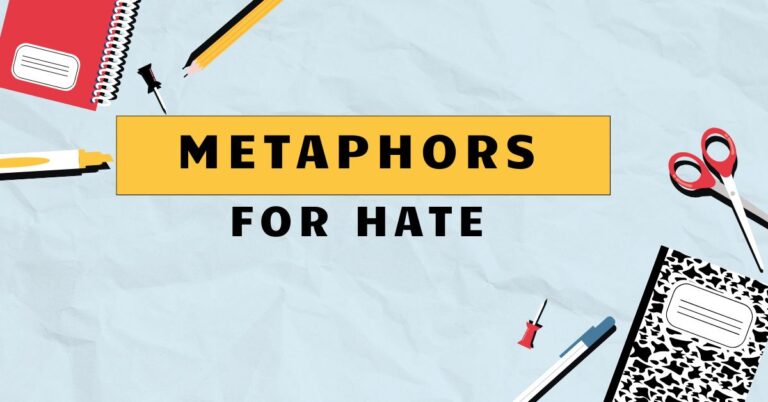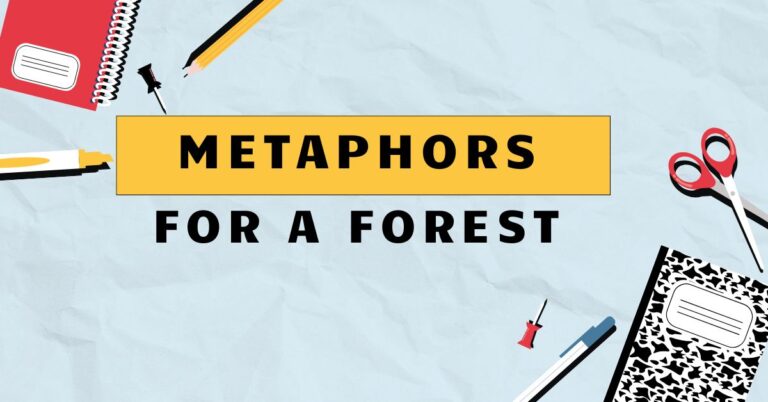35 Metaphors for Divorce: Understanding Figurative Language
Divorce, a complex and emotionally charged experience, is often described using metaphors. Understanding these metaphors is crucial for grasping the nuances of human relationships and the dissolution thereof.
This article delves into the world of metaphors used to depict divorce, exploring their structure, types, and usage. By examining these figurative expressions, we gain a deeper understanding of the social, emotional, and legal aspects of divorce.
This guide is beneficial for students of linguistics, literature, psychology, and anyone interested in understanding the power of language in describing complex human experiences.
Table of Contents
- Introduction
- Definition of Metaphor and its Role in Describing Divorce
- Structural Breakdown of Divorce Metaphors
- Types of Divorce Metaphors
- Examples of Divorce Metaphors
- Usage Rules for Divorce Metaphors
- Common Mistakes When Using Divorce Metaphors
- Practice Exercises
- Advanced Topics in Divorce Metaphors
- Frequently Asked Questions
- Conclusion
Definition of Metaphor and its Role in Describing Divorce
Ametaphoris a figure of speech that directly compares two unrelated things, asserting that they are the same or similar in some way. Unlike similes, which use words like “like” or “as” to make a comparison, metaphors make a direct assertion of equivalence.
Metaphors are used to create vivid imagery, evoke emotions, and simplify complex concepts. In the context of divorce, metaphors offer a powerful way to express the emotional, social, and legal complexities involved.
Divorce is rarely a straightforward event; it involves a tangle of emotions, legal proceedings, and social adjustments. Metaphors provide a lens through which we can understand these complexities.
By drawing parallels between divorce and other concepts, like war, journeys, or business transactions, we can better grasp the emotional toll, the legal battles, and the financial implications that often accompany the process. The use of metaphor also enables people to talk about divorce in a way that is both accessible and emotionally resonant.
Structural Breakdown of Divorce Metaphors
The structure of a metaphor typically involves two key components: thetenorand thevehicle. The tenor is the subject being described (in this case, divorce), while the vehicle is the concept used to describe it (e.g., war, journey).
The effectiveness of a metaphor lies in the connection or shared attributes between the tenor and the vehicle. Analyzing the structure reveals how specific aspects of divorce are being emphasized.
For example, in the metaphor “Divorce is a battlefield,” the tenor is divorce, and the vehicle is a battlefield. The shared attributes might include conflict, aggression, casualties, and strategic maneuvers.
Understanding this structure allows us to see how the metaphor highlights the combative aspects of divorce proceedings. Similarly, in the metaphor “Divorce is a journey,” the tenor is divorce, and the vehicle is a journey, emphasizing aspects like progress, obstacles, and a final destination.
The success of a metaphor depends on the audience’s ability to recognize and relate to the shared attributes between the tenor and the vehicle.
Types of Divorce Metaphors
Divorce metaphors can be categorized based on the underlying concept used to describe the experience. Here are some common types:
War Metaphors
War metaphors are frequently used to describe divorce, highlighting the adversarial nature of the process. These metaphors often emphasize conflict, aggression, and the struggle for victory.
Terms like “battle,” “fight,” “weapon,” and “casualty” are common in this category. These metaphors underscore the emotional and legal battles that often characterize divorce proceedings.
They can also reflect the sense of loss and damage experienced by those involved.
Journey Metaphors
Journey metaphors portray divorce as a process of moving from one state to another. These metaphors emphasize the passage of time, the obstacles encountered, and the eventual arrival at a new destination.
Terms like “path,” “road,” “obstacle,” and “destination” are typical. These metaphors can highlight the personal growth and transformation that can occur during and after divorce.
They also acknowledge the challenges and uncertainties along the way.
Business Metaphors
Business metaphors frame divorce as a transaction or negotiation. These metaphors emphasize the financial aspects of divorce, such as asset division, settlements, and legal contracts.
Terms like “assets,” “liabilities,” “negotiation,” and “settlement” are common. These metaphors can highlight the often impersonal and strategic nature of the legal process.
They also reflect the financial stakes involved in dividing property and resources.
Death Metaphors
Death metaphors depict divorce as the end of a relationship, similar to the end of a life. These metaphors emphasize loss, grief, and the finality of the separation.
Terms like “death,” “end,” “loss,” and “mourning” are typical. These metaphors can reflect the deep emotional pain and sense of closure that often accompany divorce.
They also acknowledge the grieving process that individuals may experience as they come to terms with the end of their marriage.
Construction/Destruction Metaphors
These metaphors view the marriage as a structure either being built or destroyed. These emphasize the initial creation and subsequent dismantling of shared life and dreams.
Terms like “foundation,” “building,” “demolish,” and “rebuild” are common. They underscore the effort invested in creating a life together and the impact of its dissolution.
Examples of Divorce Metaphors
Below are several examples of divorce metaphors organized by category. Each table provides a variety of examples to illustrate the different ways in which these metaphors can be used.
War Metaphors Examples:
This table provides examples of divorce metaphors that frame the experience of divorce as a war or battle. It highlights the adversarial nature of the process and the conflict involved.
| Metaphor | Explanation |
|---|---|
| Divorce is a battlefield. | Emphasizes the combative and adversarial nature of divorce. |
| She’s fighting for custody. | Portrays the custody process as a struggle or battle. |
| He launched a legal attack. | Describes legal actions as aggressive and hostile. |
| They’re locked in a bitter conflict. | Highlights the intensity and animosity of the divorce. |
| The divorce was a war of attrition. | Suggests a prolonged and exhausting battle. |
| She emerged victorious from the divorce. | Presents the divorce as a competition with a winner. |
| He surrendered his assets in the divorce. | Implies a loss or defeat in the financial aspects. |
| The lawyers were weapons in their arsenal. | Positions lawyers as tools for fighting the divorce battle. |
| The children were casualties of the divorce. | Highlights the harm inflicted on the children. |
| They drew battle lines over the property. | Depicts the division of assets as a point of conflict. |
| The divorce proceedings were a strategic maneuver. | Treats the legal process as a calculated plan. |
| He was blindsided by the divorce filing. | Describes the filing as a surprise attack. |
| The settlement was a truce. | Frames the agreement as a temporary cessation of hostilities. |
| She defended her rights fiercely. | Portrays her actions as protective and combative. |
| He retreated from the negotiations. | Suggests a withdrawal from the conflict. |
| The judge acted as a referee in the divorce battle. | The judge’s role is to mediate and enforce rules like in a sport. |
| Her words were like daggers during the mediation. | Highlights the emotional pain caused by the words exchanged. |
| He’s building his defenses to protect his assets. | Describes the preparation for legal battles as building defenses. |
| The divorce became a full-scale assault on their finances. | Emphasizes the devastating impact on their financial situation. |
| Each court appearance felt like another skirmish. | Portrays the court appearances as minor battles in the larger war. |
| The divorce was a long and arduous campaign. | Highlights the extended duration and difficulty of the process. |
| She planned her strategy carefully to achieve the best outcome. | Treats the divorce as a strategic game requiring careful planning. |
| The legal documents were like ammunition in their fight. | Positions the legal documents as tools used in the battle. |
| He felt like a prisoner of war during the proceedings. | Describes the feeling of being trapped and controlled. |
| The divorce was a test of endurance and resilience. | Highlights the need for strength and perseverance. |
Journey Metaphors Examples:
This table presents examples of divorce metaphors that depict the experience of divorce as a journey. It emphasizes the process of moving from one state to another and the challenges encountered along the way.
| Metaphor | Explanation |
|---|---|
| Divorce is a long and winding road. | Emphasizes the challenges and uncertainties of the process. |
| She’s navigating the divorce process. | Portrays the process as requiring guidance and skill. |
| He’s on a new path after the divorce. | Suggests a change in direction and life goals. |
| They’re at a crossroads in their lives. | Highlights the need to make significant decisions. |
| The divorce was a difficult journey. | Acknowledges the challenges and hardships involved. |
| She’s reaching the end of her divorce journey. | Suggests the completion of the process. |
| He’s charting a new course for his future. | Implies planning and direction in his post-divorce life. |
| The divorce was a series of detours. | Portrays the process as having unexpected obstacles. |
| She’s climbing out of the divorce valley. | Highlights the struggle to overcome difficulties. |
| He’s traveling towards a brighter future. | Suggests optimism and hope for the future. |
| The divorce proceedings were a slow trek. | Treats the legal process as a lengthy and tiring journey. |
| She’s finding her way after the divorce. | Describes the process of self-discovery and adjustment. |
| He’s turning a new page in his life. | Frames the divorce as a fresh start. |
| She’s building bridges to a new life. | Portrays her actions as creating connections and opportunities. |
| He’s leaving the past behind. | Suggests a willingness to move forward. |
| The therapist helped her navigate the emotional terrain. | Portrays emotions as a landscape that needs to be understood and traversed. |
| He’s packing his bags and moving on. | Suggests preparing for a new phase of life. |
| The divorce was a fork in the road, leading to different destinations. | Highlights the divergence of paths after the divorce. |
| She’s setting sail on a new adventure. | Portrays the future as an exciting journey. |
| He’s reaching new heights after overcoming the divorce. | Suggests personal growth and achievement. |
| The divorce was a chapter in her life’s story. | Treats the divorce as a part of a larger narrative. |
| She’s mapping out her future, one step at a time. | Describes the process of planning and setting goals. |
| He’s leaving the harbor and setting out to sea. | Suggests embarking on a new and uncertain journey. |
| The divorce was a long climb up a steep mountain. | Highlights the difficulty and effort required to overcome the challenges. |
| She’s using the divorce as a stepping stone to a better life. | Portrays the divorce as an opportunity for growth and improvement. |
Business Metaphors Examples:
This table provides examples of divorce metaphors that frame the experience of divorce as a business transaction. It emphasizes the financial aspects, negotiations, and legal contracts involved.
| Metaphor | Explanation |
|---|---|
| Divorce is a business deal. | Emphasizes the transactional nature of the process. |
| She’s negotiating the terms of the divorce. | Portrays the process as a bargaining session. |
| He’s protecting his assets in the divorce. | Suggests a focus on financial preservation. |
| They’re dividing their assets and liabilities. | Highlights the financial distribution involved. |
| The divorce was a costly transaction. | Acknowledges the financial burden of the process. |
| She’s settling the financial aspects of the divorce. | Suggests the resolution of financial matters. |
| He’s investing in his future after the divorce. | Implies a focus on financial growth and stability. |
| The divorce was a hostile takeover. | Portrays the process as aggressive and unwanted. |
| She’s cutting her losses in the divorce. | Highlights the acceptance of financial setbacks. |
| He’s restructuring his finances after the divorce. | Suggests a reorganization of financial affairs. |
| The divorce proceedings were a merger gone wrong. | Treats the marriage as a business partnership that failed. |
| She’s taking stock of her resources after the divorce. | Describes the process of assessing her financial situation. |
| He’s building a new financial portfolio. | Frames the post-divorce financial planning as an investment strategy. |
| She’s managing her debt after the divorce. | Portrays her actions as controlling and mitigating financial obligations. |
| He’s diversifying his income streams. | Suggests exploring multiple sources of revenue. |
| The lawyers acted as financial advisors during the divorce. | Highlights the role of lawyers in managing financial aspects. |
| She’s reinvesting in herself after the divorce. | Suggests using resources for personal growth and development. |
| The divorce was a business venture that went bankrupt. | Highlights the financial failure of the marriage. |
| He’s creating a budget to manage his expenses. | Portrays the process as a financial planning exercise. |
| She’s auditing her finances to ensure accuracy. | Suggests a thorough review of financial records. |
| The divorce was a leveraged buyout of their shared assets. | Treats the divorce as a complex financial transaction. |
| She’s maximizing her returns on her investments. | Describes the process of optimizing financial gains. |
| He’s minimizing his risks to protect his wealth. | Frames his actions as safeguarding his financial security. |
| The divorce settlement was a complex financial instrument. | Highlights the intricacy of the agreement. |
| She’s liquidating her assets to pay off debts. | Suggests converting assets into cash to cover obligations. |
Death Metaphors Examples:
This table provides examples of divorce metaphors that depict the experience of divorce as a death. It emphasizes the loss, grief, and finality of the separation.
| Metaphor | Explanation |
|---|---|
| Divorce is the death of a marriage. | Emphasizes the finality and end of the relationship. |
| She’s mourning the loss of her marriage. | Portrays the process as a grieving period. |
| He’s burying the past after the divorce. | Suggests a desire to move on and forget. |
| They’re saying goodbye to their shared dreams. | Highlights the loss of future plans. |
| The divorce was a painful death. | Acknowledges the emotional suffering involved. |
| She’s eulogizing the relationship. | Suggests a retrospective reflection on the marriage. |
| He’s putting the marriage to rest. | Implies a sense of closure and finality. |
| The divorce was a funeral for their love. | Portrays the process as a solemn and mournful event. |
| She’s grieving the future she lost. | Highlights the sadness over unrealized plans. |
| He’s letting go of the ghosts of the past. | Suggests releasing painful memories and regrets. |
| The divorce proceedings were like an autopsy of their relationship. | Treats the legal process as a detailed examination of the marriage’s demise. |
| She’s wearing black to signify her loss. | Describes her emotional state as one of mourning. |
| He’s building a memorial to honor what was lost. | Frames the reflection on the marriage as a tribute. |
| She’s writing an obituary for the relationship. | Portrays her actions as summarizing the end of the marriage. |
| He’s attending a wake for their shared life. | Suggests a gathering to commemorate the end of their life together. |
| The therapist helped her cope with the death of her marriage. | Highlights the professional support in dealing with the loss. |
| She’s planting flowers on the grave of her marriage. | Suggests tending to the memory of the relationship. |
| The divorce was the final nail in the coffin of their relationship. | Highlights the definitive end of the marriage. |
| He’s reading the last rites for their love. | Portrays the process as a formal farewell. |
| She’s etching a headstone for her marriage. | Suggests creating a lasting symbol of the relationship’s end. |
| The divorce was the final act in the tragedy of their marriage. | Treats the divorce as the concluding event of a sorrowful story. |
| She’s reciting a lament for the end of their shared life. | Describes the expression of sorrow and grief. |
| He’s composing an elegy for their lost love. | Frames the reflection on the marriage as a mournful poem. |
| The divorce papers were the death certificate of their marriage. | Highlights the legal confirmation of the relationship’s end. |
| She’s releasing the ashes of her marriage into the wind. | Suggests a symbolic act of letting go. |
Construction/Destruction Metaphors Examples:
This table provides examples of divorce metaphors that depict the experience of divorce as either the construction or destruction of something.
| Metaphor | Explanation |
|---|---|
| Divorce is the demolition of a shared life. | Emphasizes the destruction of what was built together. |
| She’s rebuilding her life after the divorce. | Portrays the process as constructing a new existence. |
| He’s laying the foundation for a new beginning. | Suggests establishing a solid base for the future. |
| They’re tearing down the walls of their marriage. | Highlights the dismantling of their relationship. |
| The divorce was a complete deconstruction. | Acknowledges the total dismantling of their shared life. |
| She’s constructing a new identity. | Suggests the building of a new sense of self. |
| He’s renovating his life. | Implies making improvements and changes to his lifestyle. |
| The divorce was like a house collapsing. | Portrays the marriage as a structure that crumbled. |
| She’s fortifying her emotional boundaries. | Highlights the strengthening of personal defenses. |
| He’s erecting a new framework for his future. | Suggests creating a structured plan for his life. |
| The divorce proceedings were like an architectural review of their marriage. | Treats the legal process as an evaluation of the marriage’s structure. |
| She’s designing a new blueprint for her life. | Describes her actions as creating a detailed plan. |
| He’s building a stronger foundation for his children. | Frames his actions as providing stability for his kids. |
| She’s reinforcing her support systems. | Portrays her actions as strengthening her network. |
| He’s constructing a new career path. | Suggests building a professional life. |
| The therapist helped her deconstruct her old beliefs. | Highlights the professional support in dismantling old patterns. |
| She’s adding new layers to her personality. | Suggests developing new aspects of herself. |
| The divorce was the wrecking ball that destroyed their home. | Highlights the destructive force of the divorce. |
| He’s assembling a new team of friends. | Portrays the process as building a supportive network. |
| She’s erecting barriers to protect her heart. | Suggests creating emotional defenses. |
| The divorce was the dismantling of their shared dreams. | Treats the divorce as the breakdown of their aspirations. |
| She’s laying bricks to pave the way for a better future. | Describes her actions as building towards a positive outcome. |
| He’s restructuring his finances to create stability. | Frames his actions as building a secure financial foundation. |
| The divorce papers were the architectural plans for their separate lives. | Highlights the blueprint for their individual futures. |
| She’s erecting a monument to her resilience. | Suggests creating a lasting symbol of her strength. |
Usage Rules for Divorce Metaphors
While metaphors can be powerful tools, it’s important to use them judiciously and with sensitivity. Here are some guidelines:
- Context Matters: Consider the audience and the situation. A war metaphor might be appropriate in a legal setting but insensitive in a support group.
- Avoid Clichés: Overused metaphors can lose their impact. Strive for originality and fresh perspectives.
- Be Consistent: Avoid mixing metaphors or using contradictory images. This can create confusion and weaken your message.
- Consider the Emotional Impact: Be mindful of the emotional connotations of the metaphor. Some metaphors may be triggering or insensitive to those experiencing divorce.
- Ensure Clarity: The metaphor should enhance understanding, not obscure it. If the connection between the tenor and vehicle is unclear, the metaphor will fail.
Common Mistakes When Using Divorce Metaphors
Here are some common mistakes to avoid when using divorce metaphors:
| Incorrect | Correct | Explanation |
|---|---|---|
| The divorce was a battlefield, but also a picnic. | The divorce was a brutal battlefield. | Mixing metaphors creates confusion. Stick to one consistent image. |
| She’s navigating the divorce process like a fish out of water. | She’s navigating the divorce process like a seasoned sailor. | The metaphor should make sense. A fish out of water suggests incompetence. |
| Divorce is a long and winding road, but it’s also a delicious cake. | Divorce is a long and winding road filled with obstacles. | Avoid illogical comparisons. A cake has no relevance to the divorce journey. |
| He’s rebuilding his life after the divorce, but he’s also tearing it down. | He’s rebuilding his life, brick by brick, after the divorce. | Contradictory metaphors undermine the message. |
| The divorce was a war, and the lawyers were the chefs. | The divorce was a war, and the lawyers were the generals. | The vehicle should relate to the tenor. Chefs don’t fit the war metaphor. |
Practice Exercises
Exercise 1: Identify the Metaphor
Identify the metaphor in each sentence and explain its meaning.
| Question | Answer |
|---|---|
| 1. The divorce was a financial tsunami. | Metaphor: Financial tsunami. Meaning: The divorce caused widespread and devastating financial damage. |
| 2. She’s picking up the pieces after the divorce. | Metaphor: Picking up the pieces. Meaning: She’s trying to rebuild her life after the divorce. |
| 3. He’s navigating the legal maze of the divorce. | Metaphor: Legal maze. Meaning: The legal process is complex and confusing. |
| 4. The divorce was a dark cloud hanging over their lives. | Metaphor: Dark cloud. Meaning: The divorce cast a shadow of sadness and negativity. |
| 5. She’s planting seeds for a new future. | Metaphor: Planting seeds. Meaning: She’s taking actions that will lead to a positive future. |
| 6. The divorce agreement was a minefield of legal jargon. | Metaphor: Minefield. Meaning: The agreement is full of hidden dangers and complexities. |
| 7. He felt like a puppet during the divorce proceedings. | Metaphor: Puppet. Meaning: He felt controlled and powerless. |
| 8. She’s shedding her old skin after the divorce. | Metaphor: Shedding her old skin. Meaning: She’s transforming and leaving behind her old self. |
| 9. The divorce was a shipwreck that left them stranded. | Metaphor: Shipwreck. Meaning: The divorce caused significant damage and left them in a difficult situation. |
| 10. He’s building a fortress around his heart. | Metaphor: Building a fortress. Meaning: He’s protecting himself from emotional pain. |
Exercise 2: Create a Metaphor
Create a metaphor for divorce using the given concepts.
| Concept | Your Metaphor |
|---|---|
| Weather | The divorce was a long, harsh winter, but spring is finally arriving. |
| Gardening | The marriage was a garden overgrown with weeds, and the divorce was the necessary pruning. |
| Music | The divorce was a discordant symphony, now replaced by a solo performance. |
| Sports | The divorce was a grueling marathon, but she crossed the finish line. |
| Cooking | The marriage was a recipe gone wrong, and the divorce was starting over with a fresh one. |
| Painting | The divorce was erasing an old canvas to create a new masterpiece. |
| Dancing | The marriage was a dance that ended abruptly, but now she’s learning a new routine. |
| Traveling | The divorce was a forced detour, but now she’s exploring new destinations. |
| Astronomy | The divorce was a supernova, destroying the old system but creating new elements. |
| Architecture | The divorce was tearing down an unstable structure to build a stronger one. |
Exercise 3: Choose the Best Metaphor
Choose the best metaphor to describe the following scenarios.
| Scenario | Metaphor Choices | Best Metaphor |
|---|---|---|
| A couple is bitterly fighting over assets. | A. Divorce is a business deal. B. Divorce is a battlefield. C. Divorce is a journey. | B. Divorce is a battlefield. |
| A person is trying to move on after a divorce. | A. Divorce is a death. B. Divorce is a new path. C. Divorce is a demolition. | B. Divorce is a new path. |
| A couple is dividing their finances and property. | A. Divorce is a business deal. B. Divorce is a war. C. Divorce is a funeral. | A. Divorce is a business deal. |
| A person is experiencing grief and loss after a divorce. | A. Divorce is a journey. B. Divorce is a death. C. Divorce is a construction. | B. Divorce is a death. |
| A person is trying to rebuild their life after a divorce. | A. Divorce is a demolition. B. Divorce is a construction. C. Divorce is a maze. | B. Divorce is a construction. |
| A person is feeling lost and confused during the proceedings. | A. Divorce is a maze. B. Divorce is a war. C. Divorce is a death. | A. Divorce is a maze. |
| A couple is going through a prolonged and exhausting legal battle. | A. Divorce is a sprint. B. Divorce is a marathon. C. Divorce is a stroll. | B. Divorce is a marathon. |
| A person is experiencing a significant transformation after the divorce. | A. Divorce is shedding old skin. B. Divorce is building a fortress. C. Divorce is burying the past. | A. Divorce is shedding old skin. |
| A person is protecting themselves emotionally during the divorce. | A. Divorce is building a fortress. B. Divorce is planting seeds. C. Divorce is navigating a maze. |

